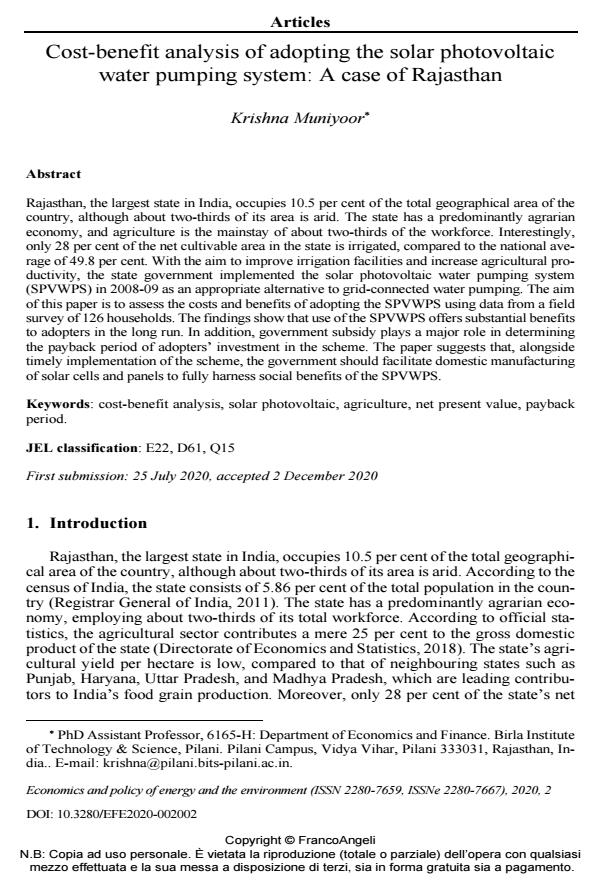Cost-benefit analysis of adopting the solar photovoltaic water pumping system: A case of Rajasthan
Titolo Rivista ECONOMICS AND POLICY OF ENERGY AND THE ENVIRONMENT
Autori/Curatori Krishna Muniyoor
Anno di pubblicazione 2021 Fascicolo 2020/2
Lingua Inglese Numero pagine 15 P. 35-49 Dimensione file 194 KB
DOI 10.3280/EFE2020-002002
Il DOI è il codice a barre della proprietà intellettuale: per saperne di più
clicca qui
Qui sotto puoi vedere in anteprima la prima pagina di questo articolo.
Se questo articolo ti interessa, lo puoi acquistare (e scaricare in formato pdf) seguendo le facili indicazioni per acquistare il download credit. Acquista Download Credits per scaricare questo Articolo in formato PDF

FrancoAngeli è membro della Publishers International Linking Association, Inc (PILA)associazione indipendente e non profit per facilitare (attraverso i servizi tecnologici implementati da CrossRef.org) l’accesso degli studiosi ai contenuti digitali nelle pubblicazioni professionali e scientifiche
Rajasthan, the largest state in India, occupies 10.5 per cent of the total geographical area of the country, although about two-thirds of its area is arid. The state has a predominantly agrarian economy, and agriculture is the mainstay of about two-thirds of the workforce. Interestingly, only 28 per cent of the net cultivable area in the state is irrigated, compared to the national average of 49.8 per cent. With the aim to improve irrigation facilities and increase agricultural productivity, the state government implemented the solar photovoltaic water pumping system (SPVWPS) in 2008-09 as an appropriate alternative to grid-connected water pumping. The aim of this paper is to assess the costs and benefits of adopting the SPVWPS using data from a field survey of 126 households. The findings show that use of the SPVWPS offers substantial benefits to adopters in the long run. In addition, government subsidy plays a major role in determining the payback period of adopters’ investment in the scheme. The paper suggests that, alongside timely implementation of the scheme, the government should facilitate domestic manufacturing of solar cells and panels to fully harness social benefits of the SPVWPS.
Parole chiave:Cost-benefit analysis, solar photovoltaic, agriculture, net present value, payback period.
Jel codes:E22, D61, Q15
- Change everything so that (almost) nothing changes? Investigating the territorial distribution of solar energy subsidies in rural India Bérénice Girard, Siddharth Sareen, in Environmental Sociology /2024 pp.385
DOI: 10.1080/23251042.2024.2372890
Krishna Muniyoor, Cost-benefit analysis of adopting the solar photovoltaic water pumping system: A case of Rajasthan in "ECONOMICS AND POLICY OF ENERGY AND THE ENVIRONMENT" 2/2020, pp 35-49, DOI: 10.3280/EFE2020-002002